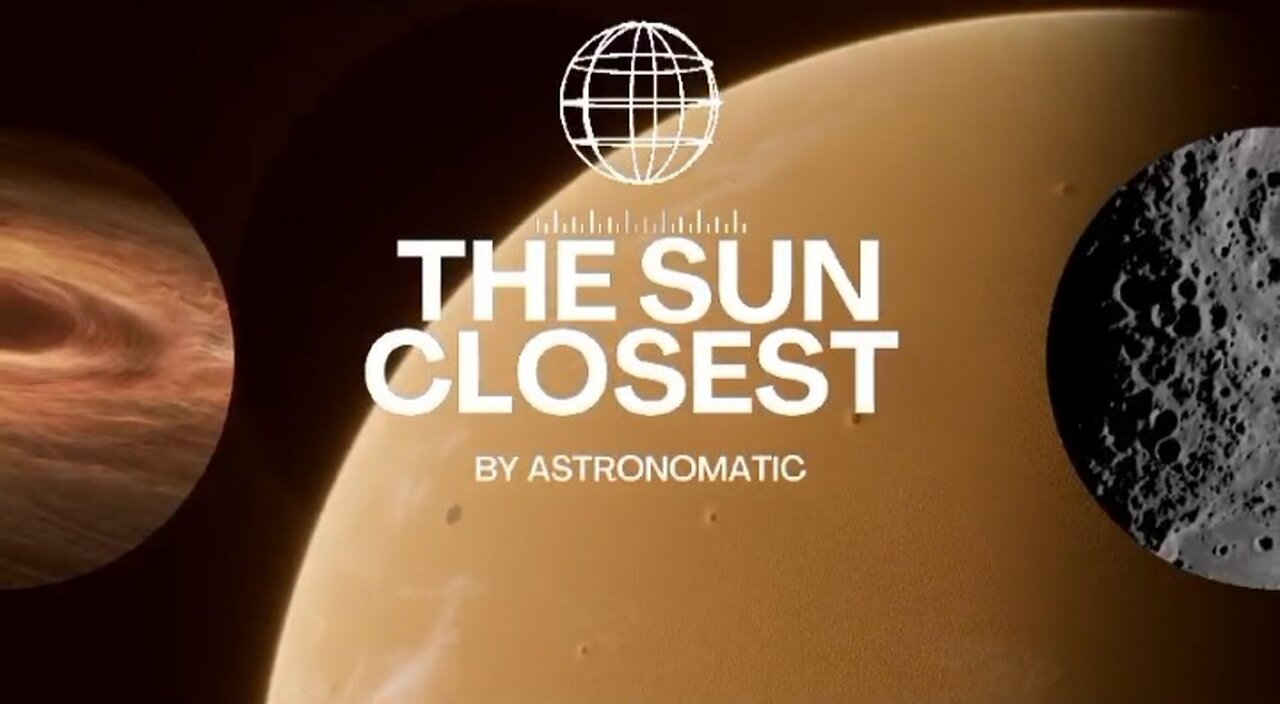Premium Only Content

The Sun Closest
The Sun is the star at the center of the Solar System. It is a massive, hot ball of plasma, inflated and heated by energy produced by nuclear fusion reactions at its core. Part of this internal energy is emitted from its surface as light, ultraviolet, and infrared radiation, providing most of the energy for life on Earth.
The Sun moves around the Galactic Center of the Milky Way, at a distance of 26,660 light-years. From Earth it is on average 1 AU (1.496×108 km) or about 8 light-minutes away. Its diameter is about 1,391,400 km (864,600 mi; 4.64 ls), 109 times that of Earth or 4 lunar distances. Its mass is about 330,000 times that of Earth, making up about 99.86% of the total mass of the Solar System.[18] Roughly three-quarters of the Sun's mass consists of hydrogen (~73%); the rest is mostly helium (~25%), with much smaller quantities of heavier elements, including oxygen, carbon, neon, and iron.[19]
The Sun is a G-type main-sequence star (G2V), informally called a yellow dwarf, though its light is actually white. It formed approximately 4.6 billion[a][14][20] years ago from the gravitational collapse of matter within a region of a large molecular cloud. Most of this matter gathered in the center, whereas the rest flattened into an orbiting disk that became the Solar System. The central mass became so hot and dense that it eventually initiated nuclear fusion in its core. It is thought that almost all stars form by this process.
Every second, the Sun's core fuses about 600 million tons of hydrogen into helium, and in the process converts 4 million tons of matter into energy. This energy, which can take between 10,000 and 170,000 years to escape the core, is the source of the Sun's light and heat. Far in the future, when hydrogen fusion in the Sun's core diminishes to the point where the Sun is no longer in hydrostatic equilibrium, its core will undergo a marked increase in density and temperature which will push its outer layers to expand, eventually transforming the Sun into a red giant. This process will make the Sun large enough to render Earth uninhabitable approximately five billion years from the present. After this, the Sun will shed its outer layers and become a dense type of cooling star (a white dwarf), and no longer produce energy by fusion, but still glow and give off heat from its previous fusion.
The enormous effect of the Sun on Earth has been recognized since prehistoric times and was thought of by some cultures as a deity. The synodic rotation of Earth and its orbit around the Sun are the basis of some solar calendars. The predominant calendar in use today is the Gregorian calendar which is based upon the standard 16th-century interpretation of the Sun's observed movement as actual movement.
-
 2:51:57
2:51:57
vivafrei
13 hours agoEp. 262: Shiloh is COINTELPRO 2.0? The "Woke Right"? Trump's Ukraine, Iran Deal! Canada Stuff & MORE
123K165 -
 1:52:05
1:52:05
IsaiahLCarter
13 hours ago $2.15 earnedAPOSTATE RADIO #013: Congestion Pricing is For The Dogs (feat. Charlie Panoff, Danny Perlstein)
24.3K1 -
 1:52:17
1:52:17
KINGKILLJ0Y
4 hours agoWhen it's DARK....it's time for RANK! //🔴LIVE
16.2K4 -
 2:06:49
2:06:49
Tundra Tactical
5 hours ago $6.46 earnedStar Wars Blaster Rankings and Other Galactic Gun News On The Galaxies Okayest Gun Live Stream
35.3K2 -
 2:09:29
2:09:29
Nerdrotic
7 hours ago $10.69 earnedAncient Precision Stone Vases Discoveries | Forbidden Frontier 100
59.5K4 -
 5:44:01
5:44:01
EricJohnPizzaArtist
6 hours agoAwesome Sauce PIZZA ART LIVE Ep. #46: Celebrating ONE YEAR on RUMBLE and Star Wars Day!
50.1K5 -
 LIVE
LIVE
iCheapshot
6 hours ago $1.51 earnedSunday Funday | Warzone Vibes
424 watching -
 54:50
54:50
Sarah Westall
6 hours agoTwo States Start Criminal Investigations against Fauci and Friends w/ Attorney Rachel Rodriguez
45K43 -
 3:15:51
3:15:51
BubbaSZN
4 hours ago🔴 LIVE - BACK TO RACING IN MEXICO (FORZA HORIZON 5)
14K1 -
 LIVE
LIVE
Major League Fishing
6 days agoLIVE! - Bass Pro Tour: Stage 4 - Day 4
2,590 watching